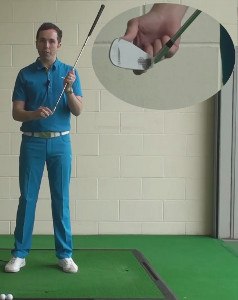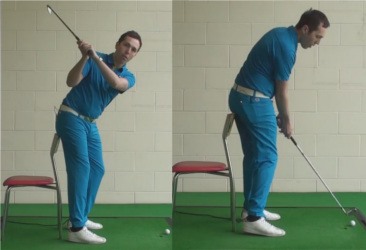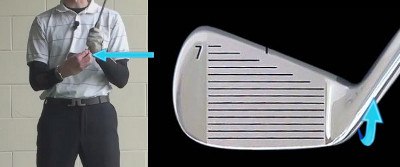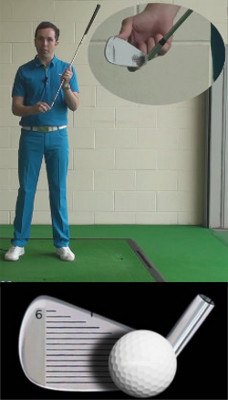
The word that sends shivers down most golfers spine is 'shanks'. A very destructive shot can completely knock the confidence and destroy the pleasure of the game for it's unexpected victims. The shanks is a shot that has hit the heel or hosel of the golf club. The golf ball hits the rounded area of the head joint causing the golf ball to shoot off in a number of different directions and heights apart from at the intended target. The most common direction the golf ball travels in is in front of the golfer i.e. for a right handed golfer to the right and a left hander to the left. It is a very damaging shot and most commonly will be repeated many times in a row.
Fault - The body moves forward towards the golf ball leaving very little room for the hands to return to the same place in which they started and the shanks/hosel becomes involved in contact. The more a golfer shanks it, the greater the body movement which makes matters much worse.
Fix - The aim of this drill is to help hit the middle of the golf club much more consistently, resulting in much better golf shots and more enjoyment of the game of golf. The best way to help find the middle of the golf club again is to maintain the posture during the downswing. You can use this drill on the practice ground or at home to master holding the body shape and posture. First use a club that you have been struggling with the shanks. Set up to the golf ball as you would do normally, making sure you are a nice distance away from the golf ball.

Top tip - When you address the golf ball, check that you are the correct distance away by practicing two key points. Firstly, when you set up to the golf ball, always place the golf club down behind the golf ball. Continue to build your stance around your golf club. Aim to set up with your hands directly below your chin and keep a good gap (about a hand's width) between the butt end of the golf club and your legs.
Check point - Rest the golf club on to your leading leg and the grip should sit about two to three inches above the knee. Be careful you do not bring your knee to the golf club.
Now you are a good distance away from the ball, place a chair or golf bag behind you so that it touches your bottom. The aim of this drill is to keep the contact with the chair or bag throughout the golf swing. Once you have kept contact, practice bringing your hands back in closer to your body at impact. This will encourage a much more centred strike on the golf club, and therefore fixing the shank shot. Once you feel confident you can achieve this without the chair or golf bag behind you, continue to create the same feeling hitting golf balls without the aid behind you.

Help Stop My Golf Shanks
There might not be a more embarrassing mistake in all of golf than the shank. Rather than sending the ball high in the air in the general direction of your target, you instead hit a low shot that heads immediately to the right (for a right-handed golfer). Not only will this type of shot cause you to hang your head in shame, it will also add at least a stroke – and probably more – to your score. No matter what level of golfer you are, or what level you strive to achieve, getting rid of your shanks should be at the top of your priority list.
This article is dedicated to the elimination of the shank. We are going to cover a variety of areas surrounding this topic, including mechanical mistakes which can lead to a shank, mental game problems, and more. The shank is both frustrating and complicated, which is what makes it so difficult to correct. To successfully get over this problem, you need to set your emotions to the side and just deal with it like you would deal with any other issue in your game. Determine the root cause of the shank, identify the necessary correction, and get down to work. There is no time to be frustrated or angry about this – just take it one step at a time and make the shank a thing of the past as soon as possible.
Another key point to address before we get started is the fact that you need to set aside any concerns about embarrassment when it comes to the shanks – or any other part of your golf game, for that matter. Golf is an extremely difficult game, and everyone hits bad shots from time to time. Even the top professionals you see on TV have hit a few shanks over the years – so there is nothing to be embarrassed about. Embrace the challenge of golf and accept the fact that things are going to go wrong from time to time. Those poor shots might be frustrating in the moment, but they will make the great shots seem that much more exciting. Remember, anyone who is out there on the course has hit plenty of bad shots of their own, so don't worry about making a mistake in their presence.
All of the content below is written from the perspective of a right-handed golfer. If you happen to play left-handed, please take a moment to reverse the directions as necessary.

What Went Wrong?
This is the question that most golfers ask themselves as soon as they see the ball scurry off to the right as the result of a shank. Unfortunately, many golfers don't actually understand what a shank is, or where it comes from. This misunderstanding is a big part of the reason that many golfers never manage to eliminate the shank from their game. To get our article started, we are first going to provide you with some information on what actually happens when a shank occurs. By gaining a clear understanding of this issue, you will have a much better chance to correct your shanks once and for all.
A shank is a shot which is struck on the hosel of the golf club. The hosel is the section of the club where the shaft and the club head come together. While all golf clubs technically have a hosel, it is your irons which are most likely to create a shank due to their design. It would be quite rare – and in some cases, virtually impossible – to hit a true shank with a club such as a driver or three wood. The angled design of the hosel on most irons makes is possible to shank the ball if you miss the center of the club face at impact.
Already, we see one major misconception coming unraveled. Many golfers think that a shanked shot has been hit off the toe of the club, since the ball was sent out to the right. This is a logical enough line of thinking, but it is incorrect. When you hit a shank, it is almost certain that the hosel of the club came in contact with the ball. In fact, if you look closely at the hosel after hitting a shank, you will likely see an imprint where the ball made contact with the club. Thinking that they have hit the ball on the toe, many golfers will try to consciously swing farther out away from their bodies on the way down – which is only going to make a shank even more likely.
To get rid of your shanks, you have to keep the hosel of the golf club safely away from the ball at impact. Of course, that is going to be easier said than done, but at least now you have a clear understanding of the problem, and the goal. You already knew that you should be trying to hit the ball on the sweet spot, but you might not have known where you were going wrong. There should now be no doubt in your mind as to what has happened when you hit a shank – the ball came off the hosel of the club, and shot immediately to the right. Get the ball away from the hosel, and your shanks will simply disappear. Moving forward in this article, we will offer a variety of tips to help you make that happen.

Common Causes of a Shank
You aren't going to be able to fix your shank until you figure out exactly where the shank is coming from in the first place. Too many golfers go out looking for cures before they even know what is wrong. Sure, they might know that they are shanking the ball, but they don't yet know why. Without that critical piece of information, it will be nearly impossible to reach a successful outcome.
The points below are going to highlight some of the common causes of the shank. Most likely, the underlying cause of your persistent shanks can be found in the following list.
- Standing too close to the ball. This is the first place you should look for a shank cause. If you are standing too close to the ball, you won't have enough room to swing the club freely through the hitting area – and the hosel might wind up contacting the ball as a result. You don't want to be reaching out for the ball at address, but you shouldn't feel crowded, either. Look to find a middle ground where you can let your arms hang freely from your shoulders while lining the club up behind the ball. There is no 'perfect' distance from the ball which will work for all players, since so much depends on your body type, swing style, and more. Experiment with a variety of distances from the ball until you settle on one that feels comfortable and doesn't seem to lead to any shanks.
- Leaning out over the ball in the downswing. Poor balance is the cause of a long list of swing problems in this game. If you are hitting shanks on a regular basis, it may be that you are leaning out over the ball on the way down, and as a result, you are too close to the ball when impact arrives. To wind up leaning forward in the downswing, there is a good chance you are leaning back during the backswing. In other words, you are rocking onto your heels going back, and then you reverse the move on the way down and wind up on your toes. To eliminate all of this movement, think about centering yourself with your weight balanced in the middle of your feet throughout the swing. The golf swing should be a rotational movement with very little lateral motion taking place. Set your weight perfectly over the middle of your feet at address and do your best to stay there throughout the swing. With improved balance, it will be significantly easier to achieve a clean strike with no shank in sight.
- Failure to turn. While it is smart to check on the first two points to make sure they aren't causing a problem, it is likely this last point which is causing you to hit a shank. When you don't turn properly in the downswing, your lower body fails to get out of the way – and you are likely to hit a shank as a result. At this point, it is simply a lack of space that is to blame. Your hips and legs should have turned through the shot and gotten out of the way. If that has not happened, your hands are going to have to move out toward the ball just to swing through cleanly. In moving closer to the ball, you are going to inevitably run the risk of hitting a shank. Not all of these kinds of swings are going to result in a shank, but many of them will. There is a very small difference between a shank and a decent shot – less than an inch – so we are talking about very small margins here. If you can learn how to get your lower body through the shot and out of the way, you can maintain all the space you need to fire through the ball cleanly without any possibility of a shank.
The list above does not cover every possible cause of the shanks, because that would be virtually impossible. There are an infinite number of different ways you can swing the club, and that means that there are just as many ways to hit a shank. If you don't think you are making any of the mistakes above, it might be a good idea to have your swing recorded on video so you can break it down more carefully. The answer is hiding in there somewhere – it is up to you to break things down until you can figure it out.
Finding the cause of your shank problem will be both a big relief and the start of a lengthy journey. Once you understand why you have been shanking the golf ball, you can then get to work on making the necessary fix. Of course, that fix is going to depend completely on what you have determined to be the underlying cause. If you were standing too close to the ball, you will obviously want to start by moving back. However, the entire fix might not be that simple. Once you move back, you might find that other changes need to be made before you can dial in your ball striking just right.
We can't exactly tell you how you are going to be able to fix your shanks because the answer depends on the problem. Once you figure out why you are hitting a shank, the solution will make itself clear. From there, it is nothing more than a matter of hard work and determination.

The Mental Side of the Shanks
Truth be told, the shanks are more of a mental problem than a physical one. Yes, you need to correct your physical mistakes in order to get rid of your shank once and for all, but you also need to correct the way you think during your swing. The shanks have a way of getting in your head like almost nothing else in this game, with the possible exception of the yips. Whether it is the shanks or the yips that are giving you trouble, straightening out your way of thinking is essential.
When you hit your first shank – or, at least, your first shank in a while – it is likely to be a bit of a shock. You will be surprised by the shot, and it will probably get in your head. This is the big challenge with regard to the shank – you have to find a way to not allow it to eat away at your confidence. You need to think of that shank as an isolated incident, not the start of a trend. If you expect the shanks to continue, they almost certainly will.
Once the shanks become a problem, one of the best things you can do is to get to the practice range to hit plenty of balls. By hitting a lot of shots on the range, you should hopefully be able to build up your confidence to its previous level. Instead of thinking about the shanks the next time you are on the course, you will just be thinking about all the great shots you hit in your most recent practice session. This is a great way to replace negative thinking with positivity. By turning your mind in a positive direction thanks to a solid practice session, you can force the shanks out of your thought process – and hopefully, out of your game entirely.
Another key when you are fighting the shanks is to keep your ball out of situations where shanks are more likely. While it is technically possible to shank any golf shot, the shanks tend to pop up more frequently when trying to hit some kind of soft shot. For example, if you are making a soft swing in order to hit a pitch shot of 50 or 60 yards, you might expose the hosel to the ball and hit a shank due to a poor turn through the hitting area. If you can leave yourself with nothing but full shots for the entire round, you will have a much better chance of avoiding the dreaded shank.
Above all else, you can't let the worry over a possible shank take over your game to the point where that is all you think about. Sure, it is no fun to hit a shank, but it is also no fun to spend all day thinking about a mistake that may not ever happen. Instead of dreading a possible shank in the future, focus on each shot as it comes and expect good results. Even if you do hit one or two shanks over the course of the round, there may be enough other good shots to make up for those costly errors.

A Handy Drill
If you are hitting a shank, the hosel of the club is coming into contact with the ball – meaning you are swinging the club through the hitting area slightly too far away from your body. To correct this mistake, you naturally need to bring the club back in closer to you, by just an inch or two. To help you achieve this adjustment, you can use the drill we are going to describe below.
To perform this drill, you will need to be at a driving range with a natural turf hitting area (rather than artificial mats). Once you have arrived at such a facility, use the steps below to get down to work.
- For this drill, you will need some golf balls to hit, a couple of tees, and your seven iron (or another middle iron).
- The setup for the drill is quite simple. Place the first golf ball down on the ground in front of you, and pick out a target for the shot. Once you have your target in mind, set your club head down behind the ball as if you were going to hit the shot. However, before starting your swing, reach down and place the two tees into the ground. One tee is going to be placed in the turf just outside of the toe of the club, while the other is going to be placed just inside the heel.
- With these two tees in the ground, you will have effectively created a 'gate' for your swing. Now, you are simply going to do your best to swing cleanly through the gate without contacting either tee. If you can do so effectively, you will strike the ball on or near the sweet spot, and there will be no worries about a shank. Only when you wipe out the outside tee – meaning you swing through too far to the outside – will you have to worry about hitting a shank off to the right.
- Feel free to hit as many shots as you like by swinging through the gate. This drill should help you visualize how the club needs to move through the hitting area. Even when you are out on the course, you can picture having two tees in the ground around your club head just to give yourself some confidence for the swing.
This is one of the simplest drills you can perform, but it is one of the most effective for those dealing with a shank. By doing this drill, you will get away from thinking about the technical parts of your swing, and instead you will be able to think only about the path the club needs to take through the ball. If you can simply deliver the club on the right path through the hitting area, nothing else will matter. You will be able to strike your shots on or near the sweet spot most of the time, and you will stay safely away from the hosel. Try to add this drill to your practice routine as a way to build confidence in the fact that there will be no shanks appearing in your game anytime soon. Also, this drill can be used on the practice green to work on your putting stroke. While shanks aren't a problem when putting, it is still important to swing through accurately in order to hit the sweet spot.
No golfer likes to talk about the shanks, and some refuse to even say the word. However, you don't need to run in the other direction from this topic, afraid of letting it infect your game. The best thing you can do is meet the issue head-on, figuring out why you are hitting shanks and then getting to work on a solution right away. Good luck!






